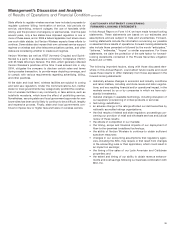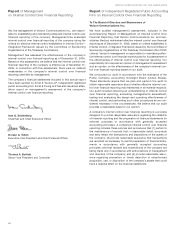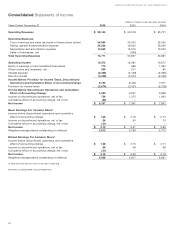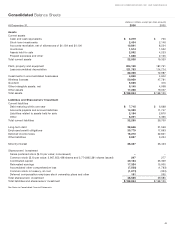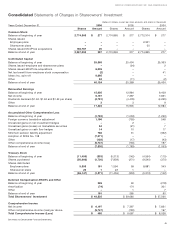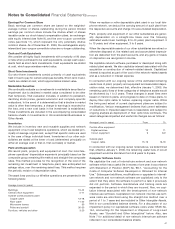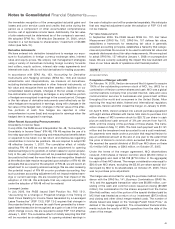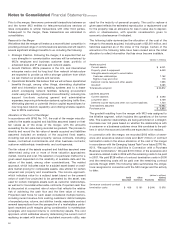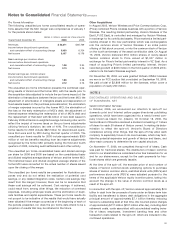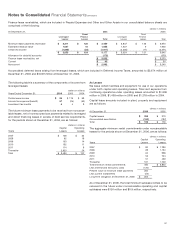Verizon Wireless 2006 Annual Report Download - page 51
Download and view the complete annual report
Please find page 51 of the 2006 Verizon Wireless annual report below. You can navigate through the pages in the report by either clicking on the pages listed below, or by using the keyword search tool below to find specific information within the annual report.
Notes to Consolidated Financial Statements continued
49
the immediate recognition of the unrecognized actuarial gains and
losses and prior service costs and credits that arise during the
period as a component of other accumulated comprehensive
income, net of applicable income taxes. Additionally, the fair value
of plan assets must be determined as of the company’s year-end.
We adopted SFAS No. 158 effective December 31, 2006, which
resulted in a net decrease to shareowners’ investment of $6,883
million (see Note 15).
Derivative Instruments
We have entered into derivative transactions to manage our expo-
sure to fluctuations in foreign currency exchange rates, interest
rates and equity prices. We employ risk management strategies
using a variety of derivatives including foreign currency forwards
and collars, equity options, interest rate swap agreements and
interest rate locks. We do not hold derivatives for trading purposes.
In accordance with SFAS No. 133, Accounting for Derivative
Instruments and Hedging Activities (SFAS No. 133) and related
amendments and interpretations, we measure all derivatives,
including derivatives embedded in other financial instruments, at
fair value and recognize them as either assets or liabilities on our
consolidated balance sheets. Changes in the fair values of deriva-
tive instruments not qualifying as hedges or any ineffective portion
of hedges are recognized in earnings in the current period. Changes
in the fair values of derivative instruments used effectively as fair
value hedges are recognized in earnings, along with changes in the
fair value of the hedged item. Changes in the fair value of the effec-
tive portions of cash flow hedges are reported in other
comprehensive income (loss) and recognized in earnings when the
hedged item is recognized in earnings.
Other Recent Accounting Pronouncements
Uncertainty in Income Taxes
In July 2006, the FASB issued Interpretation No. 48, “Accounting for
Uncertainty in Income Taxes” (FIN 48). FIN 48 requires the use of a
two-step approach for recognizing and measuring tax benefits taken
or expected to be taken in a tax return and disclosures regarding
uncertainties in income tax positions. We are required to adopt FIN
48 effective January 1, 2007. The cumulative effect of initially
adopting FIN 48 will be recorded as an adjustment to opening
retained earnings (or to goodwill, in certain cases for a prior acquisi-
tion) in the year of adoption and will be presented separately. Only
tax positions that meet the more likely than not recognition threshold
at the effective date may be recognized upon adoption of FIN 48. We
anticipate that as a result of the adoption of FIN 48, we will record an
adjustment to our opening retained earnings. We are also reviewing
the potential impact of FIN 48 on prior purchase accounting. Any
such purchase accounting adjustment will not impact retained earn-
ings or current earnings. We are reviewing the final impact of the
adoption of FIN 48. We anticipate that any required adjustment
under the adoption of FIN 48 will not be material.
Leveraged Leases
In July 2006, the FASB issued Staff Position No. FAS 13-2,
“Accounting for a Change or Projected Change in the Timing of
Cash Flows Relating to Income Taxes Generated by a Leveraged
Lease Transaction” (FSP 13-2). FSP 13-2 requires that changes in
the projected timing of income tax cash flows generated by a lever-
aged lease transaction be recognized as a gain or loss in the year in
which change occurs. We are required to adopt FSP 13-2 effective
January 1, 2007. The cumulative effect of initially adopting this FSP
will be recorded as an adjustment to opening retained earnings in
the year of adoption and will be presented separately. We anticipate
that any required adjustment under the adoption of FSP 13-2 will
not be material.
Fair Value Measurements
In September 2006, the FASB issued SFAS No. 157, Fair Value
Measurement (SFAS No. 157). SFAS No. 157 defines fair value,
establishes a framework for measuring fair value in generally
accepted accounting principles, establishes a hierarchy that catego-
rizes and prioritizes the sources to be used to estimate fair value and
expands disclosures about fair value measurements. We are required
to adopt SFAS No. 157 effective January 1, 2008 on a prospective
basis. We are currently evaluating the impact this new standard will
have on our future results of operations and financial position.
NOTE 2
ACQUISITIONS
Completion of Merger with MCI
On February 14, 2005, Verizon announced that it agreed to acquire
100% of the outstanding common stock of MCI, Inc. (MCI) for a
combination of Verizon common shares and cash. MCI was a global
communications company that provided Internet, data and voice
communication services to businesses and government entities
throughout the world and consumers in the United States. After
receiving the required state, federal and international regulatory
approvals, Verizon and MCI closed the merger on January 6, 2006.
On April 9, 2005, Verizon entered into a stock purchase agreement
with eight entities affiliated with Carlos Slim Helú to purchase 43.4
million shares of MCI common stock for $25.72 per share in cash
plus an additional cash amount of 3% per annum from April 9,
2005, until the closing of the purchase of those shares. The trans-
action closed on May 17, 2005. The total cash payment was $1,121
million and the investment was accounted for as a cost investment.
No payments were made under a provision that required Verizon to
pay an additional amount at the end of one year to the extent that
the price of Verizon’s common stock exceeded $35.52 per share.
We received the special dividend of $5.60 per MCI share on these
43.4 million MCI shares, or $243 million, on October 27, 2005.
Under the terms of the merger agreement, MCI shareholders
received .5743 shares of Verizon common stock ($5,050 million in
the aggregate) and cash of $2.738 ($779 million in the aggregate)
for each of their MCI shares. The merger consideration was equal to
$20.40 per MCI share, excluding the $5.60 per share special divi-
dend paid by MCI to its shareholders on October 27, 2005. There
was no purchase price adjustment.
The merger was accounted for using the purchase method in accor-
dance with the SFAS No. 141, Business Combinations (SFAS No.
141), and the aggregate transaction value was $6,890 million, con-
sisting of the cash and common stock issued at closing ($5,829
million), the consideration for the shares acquired from the Carlos
Slim Helú entities, net of the portion of the special dividend paid by
MCI that was treated as a return of our investment ($973 million)
and closing and other direct merger-related costs. The number of
shares issued was based on the “Average Parent Stock Price,” as
defined in the merger agreement. The consolidated financial state-
ments include the results of MCI’s operations from the date of the
close of the merger.


